Melasma is a chronic skin condition marked by symmetrical patches of hyperpigmentation, most commonly on the face. While its exact cause remains multifactorial ranging from hormonal fluctuations to UV exposure. One thing is clear: a melasma treatment cream remain the cornerstone of non-invasive melasma management.
There are only a few melasma treatment cream in the market today. Pynocare Melasma Cream has emerged as a standout option, not just for its cosmetic benefits but for its scientifically backed formulation that targets melanin production at multiple levels.
Why Cream-Based Treatments Work for Melasma
Melasma treatment creams are effective because they deliver active ingredients directly to the epidermis, where melanocytes reside. Unlike oral supplements or procedural treatments, creams can be used daily, are generally well-tolerated, and allow for targeted application on affected areas.
The success of melasma treatment creams depend on their ability to:
- Inhibit melanin synthesis
- Block melanin transfer to skin cells
- Reduce inflammation and oxidative stress
- Protect against UV-induced pigmentation
Pynocare Melasma Cream addresses all these mechanisms through a multi-functional blend of clinically studied ingredients.
Targeted Ingredients in Pynocare Melasma Cream: Mechanisms and Evidence
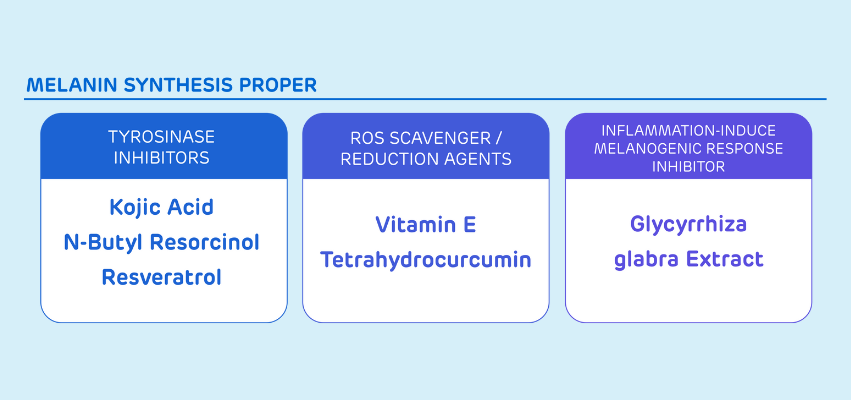
Let’s take a look at how each key ingredient works on the skin and what clinical evidence supports its role as a melasma treatment cream.
1. N-Butyl Resorcinol
N-Butyl Resorcinol is a synthetic compound known for its high potency in inhibiting tyrosinase. Unlike older agents such as hydroquinone, which can cause irritation and rebound pigmentation, N-Butyl Resorcinol offers a safer and more targeted approach.
Mechanism: This compound inhibits tyrosinase, the enzyme responsible for the first step in melanin synthesis. It also blocks peroxidase, another enzyme involved in pigment formation.
Clinical Evidence: A study published in the British Journal of Dermatology found that 0.3% rucinol cream shown to have significant efficacy compared with vehicle alone in improving melasma after 3 months of treatment (Khemis et al., 2007).
Effect: Reduces the intensity of dark spots and prevents new pigmentation from forming.
2. Kojic Acid
Kojic acid is a fungal metabolite that has long been used in dermatology for its skin-lightening properties. When used in combination with other agents, kojic acid enhances the overall efficacy of melasma treatment, contributing to a brighter and more even complexion.
Mechanism: Kojic acid chelates copper ions required for tyrosinase activity, thereby suppressing melanin production. It also has mild antibacterial and antioxidant properties.
Clinical Evidence: Kojic acid has been shown to significantly reduce hyperpigmentation in multiple studies, especially when combined with other agents like glycolic acid or hydroquinone (Lim et al., 2017).
Effect: Lightens existing pigmentation and enhances skin clarity.
3. Niacinamide (Vitamin B3)
Niacinamide, also known as Vitamin B3, is a multifunctional skincare ingredient with a well-established role in treating hyperpigmentation.
Mechanism: Niacinamide interferes with the transfer of melanosomes (pigment granules) from melanocytes to keratinocytes. It also strengthens the skin barrier and reduces inflammation.
Clinical Evidence: A randomized controlled trial published in Dermatology demonstrated that 4% niacinamide significantly improved melasma after eight weeks of use (Navarrete-Solís et al., 2011).
Effect: Reduces visible pigmentation and improves skin resilience.
4. Tetrahydrocurcumin
Oxidative stress and inflammation are key contributors to melanocyte activation. It is known for its potent antioxidant and anti-inflammatory properties. Additionally, tetrahydrocurcumin inhibits tyrosinase, further contributing to its depigmenting effects. Its gentle nature makes it suitable for sensitive skin, providing therapeutic benefits without causing irritation.
Mechanism: A metabolite of curcumin, tetrahydrocurcumin acts as a potent antioxidant and anti-inflammatory agent. It inhibits tyrosinase and scavenges reactive oxygen species (ROS), which are known to stimulate melanin production.
Clinical Evidence: Studies have shown that tetrahydrocurcumin reduces UV-induced pigmentation and improves skin tone when applied topically (Chainani-Wu, 2003).
Effect: Calms inflammation and reduces oxidative stress, both of which contribute to melasma.
5. Vitamin F (Linoleic and Linolenic Acids)
In melasma, compromised skin barrier function can lead to increased sensitivity and inflammation, both of which exacerbate pigmentation. By replenishing these fatty acids, Vitamin F helps restore the skin’s barrier.
Mechanism: These essential fatty acids help restore the skin’s lipid barrier, reducing transepidermal water loss and preventing irritation. Linoleic acid also downregulates melanogenesis by modulating prostaglandin pathways.
Clinical Evidence: Research suggests that topical linoleic acid reduced UV-induced pigmentation and improved skin barrier function (Wang et al., 2025).
Effect: Enhances skin health and reduces pigmentation triggers.
6. Vitamin E (Tocopherol)
Oxidative stress is a known trigger for melanocyte activation. By neutralizing free radicals, Vitamin E helps prevent the cascade of events that lead to increased melanin production.
Mechanism: Vitamin E neutralizes free radicals and protects skin cells from oxidative damage. It also stabilizes cell membranes and supports skin healing.
Clinical Evidence: When combined with Vitamin C, Vitamin E has shown synergistic effects in reducing UV-induced pigmentation and improving skin texture (Lin et al., 2003).
Effect: Protects skin from environmental stress and supports recovery.
7. Resveratrol
Resveratrol is a polyphenolic compound found in grapes, berries, and red wine. In vitro studies have confirmed its ability to reduce melanin content in melanocytes, and its antioxidant profile helps protect the skin from UV-induced damage.
Mechanism: Resveratrol inhibits melanogenesis by downregulating MITF (microphthalmia-associated transcription factor), a key regulator of melanin production. It also reduces inflammation and oxidative stress.
Clinical Evidence: Clinical evidence demonstrated that resveratrol significantly inhibits proliferation, promotes differentiation and melanogenesis (Lei et al., 2017).
Effect: Reduces pigmentation at the cellular level and improves skin tone.
8. Glycyrrhiza glabra (Licorice) Extract
It is particularly effective in treating melasma because it not only lightens pigmentation but also calms irritated skin, which can otherwise stimulate melanocyte activity.
Mechanism: Glabridin, the active compound in licorice extract, inhibits tyrosinase and has anti-inflammatory properties. It also prevents UVB-induced pigmentation.
Clinical Evidence: Studies have shown that glabridin reduces melanin synthesis and protects against skin inflammation (Fuhrman et al., 1997).
Effect: Lightens dark spots and soothes irritated skin.
9. Octyl Methoxycinnamate
Sun exposure is one of the most significant triggers for melasma. Octyl Methoxycinnamate is a chemical sunscreen agent that absorbs UVB rays, preventing them from reaching the deeper layers of the skin. By blocking UV radiation, this ingredient helps prevent the activation of melanocytes and the subsequent production of melanin.
Mechanism: This UVB filter absorbs harmful rays before they penetrate the skin, preventing UV-induced activation of melanocytes.
Clinical Evidence: Widely used in sunscreens, octyl methoxycinnamate has been proven to reduce sunburn and prevent pigmentation when used regularly (Xu et al., 2021).
Effect: Shields skin from UV damage, a major trigger for melasma.
Why Pynocare Melasma Cream Is a Smart Choice
Pynocare melasma treatment cream is more than a cosmetic solution. It is a scientifically formulated treatment that addresses melasma through multiple pathways: melanin inhibition, antioxidant protection, skin barrier repair, and sun defense. Its ingredients are backed by clinical research and dermatological science, making it a trusted option for those seeking a non-invasive, effective cream-based treatment.
Where to Buy
To get your melasma treatment cream, Pynocare Melasma Cream is available at:
- Mercury Drug (physical stores)
- Watsons (physical and online stores)
Visit your nearest branch or shop online at Watsons to begin your journey toward clearer, melasma-free skin.
References
Khemis, A., Kaiafa, A., Queille-Roussel, C., Duteil, L., & Ortonne, J. P. (2007). Evaluation of efficacy and safety of rucinol serum in patients with melasma: a randomized controlled trial. The British Journal of dermatology, 156(5), 997–1004. https://doi.org/10.1111/j.1365-2133.2007.07814.x
Lim J. T. (1999). Treatment of melasma using kojic acid in a gel containing hydroquinone and glycolic acid. Dermatologic Surgery, 25(4), 282–284. https://doi.org/10.1046/j.1524-4725.1999.08236.x
Navarrete-Solís, J., Castanedo-Cázares, J. P., Torres-Álvarez, B., Oros-Ovalle, C., Fuentes-Ahumada, C., González, F. J., Martínez-Ramírez, J. D., & Moncada, B. (2011). A Double-Blind, Randomized Clinical Trial of Niacinamide 4% versus Hydroquinone 4% in the Treatment of Melasma. Dermatology research and practice, 2011, 379173. https://doi.org/10.1155/2011/379173
Chainani-Wu, N. (2003). Safety and anti-inflammatory activity of curcumin: a component of turmeric (Curcuma longa). Journal of Alternative and Complementary Medicine, 9(1), 161–168. https://doi.org/10.1089/107555303321223035
Wang, X., Jia, Y., & He, H. (2024). The Role of linoleic acid in skin and hair health: a review. International Journal of Molecular Sciences, 26(1), 246. https://doi.org/10.3390/ijms26010246
Lin, J. Y., & Lin, J. L. (2003). Synergistic photoprotection by green tea polyphenols and sunscreens. Journal of the American Academy of Dermatology, 48(6), 866–874. https://doi.org/10.1067/mjd.2003.425
Lei, M. J., Dong, Y., Sun, C. X., & Zhang, X. H. (2017). Resveratrol inhibits proliferation, promotes differentiation and melanogenesis in HT-144 melanoma cells through inhibition of MEK/ERK kinase pathway. Microbial Pathogenesis, 111, 410–413. https://doi.org/10.1016/j.micpath.2017.09.029
Fuhrman, B., Buch, S., Vaya, J., Belinky, P. A., Coleman, R., Hayek, T., & Aviram, M. (1997). Licorice extract and its major polyphenol glabridin protect low-density lipoprotein against lipid peroxidation: in vitro and ex vivo studies in humans and in atherosclerotic apolipoprotein E-deficient mice. The American Journal of Clinical Nutrition, 66(2), 267–275. https://doi.org/10.1093/ajcn/66.2.267
Xu, C., Zeng, X., Yang, Z., & Ji, H. (2021). Sunscreen Enhancement of Octyl Methoxycinnamate Microcapsules by Using Two Biopolymers as Wall Materials. Polymers, 13(6), 866. https://doi.org/10.3390/polym13060866
PYNOCARE (Procyanidin + Ascorbic Acid + Betacarotene + d-Alpha-Tocopheryl Acetate)
The first and only oral medicine that is clinically proven to reduce Melasma or dark spots formation in just 8 weeks. Unlike creams, lotions, and gels, it has MSCC or Melasma Skin Clear Complexion Complex formulation that deeply penetrates the inner layers of the skin, to help normalize melanin levels, thus minimizing the appearance of dark spots in a short time.
Mega Lifesciences Limited Inc. or Mega We Care, is actively involved in helping millions of people have access to safe, effective, world-class quality nutritional & herbal supplements, OTC, and ethical products.

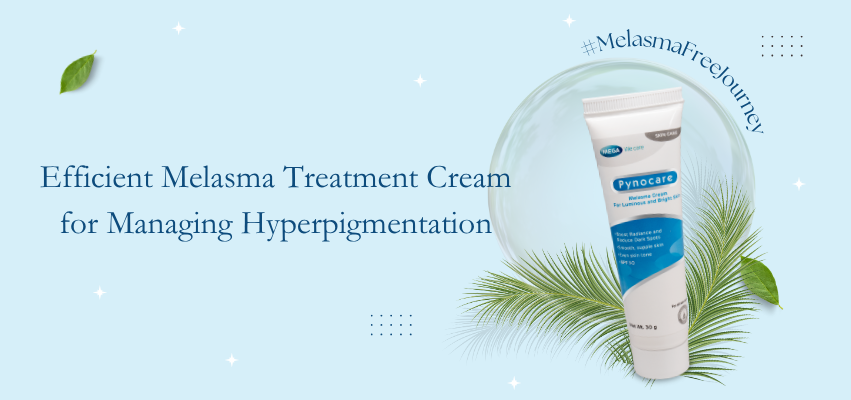
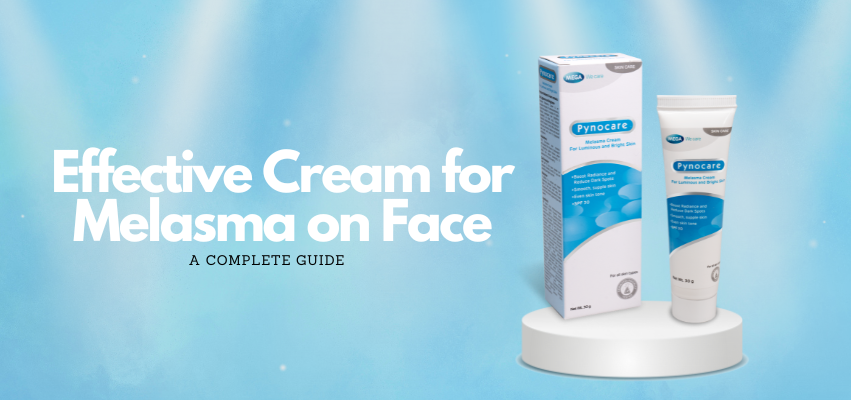
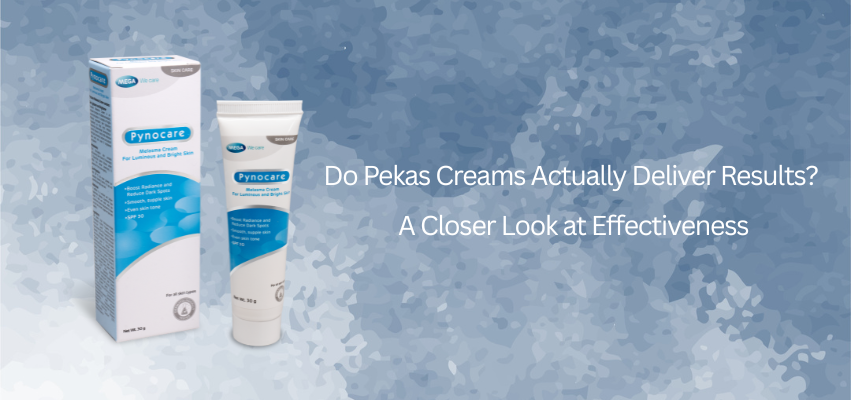


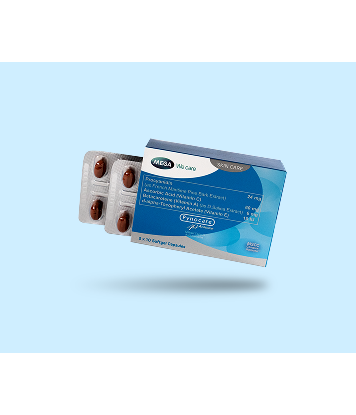













No Comments on Efficient Melasma Treatment Cream for Managing Hyperpigmentation